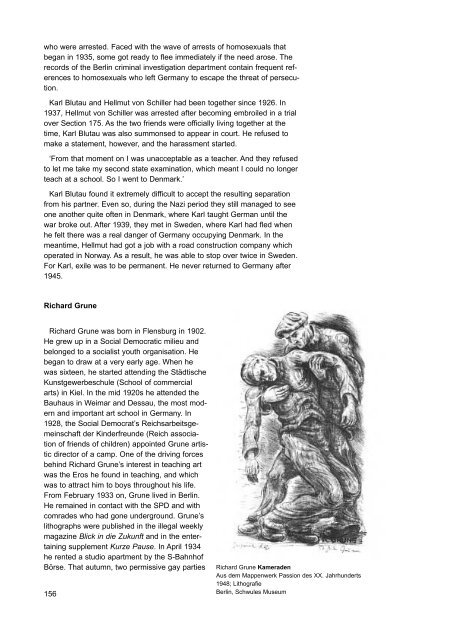Download PDF - Gedenkort für die im Nationalsozialismus ...
Download PDF - Gedenkort für die im Nationalsozialismus ...
Download PDF - Gedenkort für die im Nationalsozialismus ...
Erfolgreiche ePaper selbst erstellen
Machen Sie aus Ihren PDF Publikationen ein blätterbares Flipbook mit unserer einzigartigen Google optimierten e-Paper Software.
who were arrested. Faced with the wave of arrests of homosexuals thatbegan in 1935, some got ready to flee <strong>im</strong>mediately if the need arose. Therecords of the Berlin cr<strong>im</strong>inal investigation department contain frequent referencesto homosexuals who left Germany to escape the threat of persecution.Karl Blutau and Hellmut von Schiller had been together since 1926. In1937, Hellmut von Schiller was arrested after becoming embroiled in a trialover Section 175. As the two friends were officially living together at thet<strong>im</strong>e, Karl Blutau was also summonsed to appear in court. He refused tomake a statement, however, and the harassment started.‘From that moment on I was unacceptable as a teacher. And they refusedto let me take my second state examination, which meant I could no longerteach at a school. So I went to Denmark.’Karl Blutau found it extremely difficult to accept the resulting separationfrom his partner. Even so, during the Nazi period they still managed to seeone another quite often in Denmark, where Karl taught German until thewar broke out. After 1939, they met in Sweden, where Karl had fled whenhe felt there was a real danger of Germany occupying Denmark. In themeant<strong>im</strong>e, Hellmut had got a job with a road construction company whichoperated in Norway. As a result, he was able to stop over twice in Sweden.For Karl, exile was to be permanent. He never returned to Germany after1945.Richard GruneRichard Grune was born in Flensburg in 1902.He grew up in a Social Democratic milieu andbelonged to a socialist youth organisation. Hebegan to draw at a very early age. When hewas sixteen, he started attending the StädtischeKunstgewerbeschule (School of commercialarts) in Kiel. In the mid 1920s he attended theBauhaus in We<strong>im</strong>ar and Dessau, the most modernand <strong>im</strong>portant art school in Germany. In1928, the Social Democrat’s Reichsarbeitsgemeinschaftder Kinderfreunde (Reich associationof friends of children) appointed Grune artisticdirector of a camp. One of the driving forcesbehind Richard Grune’s interest in teaching artwas the Eros he found in teaching, and whichwas to attract h<strong>im</strong> to boys throughout his life.From February 1933 on, Grune lived in Berlin.He remained in contact with the SPD and withcomrades who had gone underground. Grune’slithographs were published in the illegal weeklymagazine Blick in <strong>die</strong> Zukunft and in the entertainingsupplement Kurze Pause. In April 1934he rented a studio apartment by the S-BahnhofBörse. That autumn, two permissive gay parties156Richard Grune KameradenAus dem Mappenwerk Passion des XX. Jahrhunderts1948; LithografieBerlin, Schwules Museum


